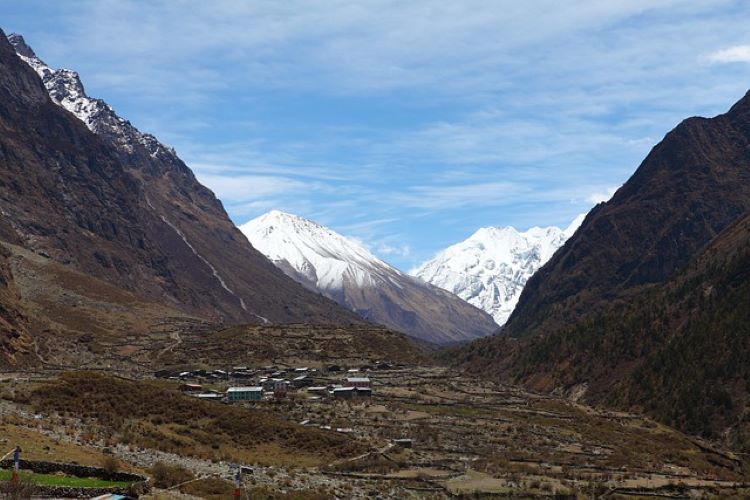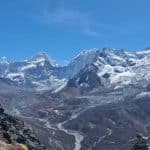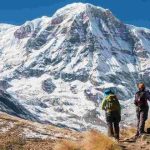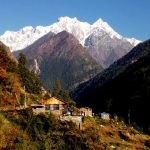Langtang Valley

Langtang Valley is a stunning region in the north of Nepal that is located in the Langtang National Park. It is known for its beautiful landscape, which includes mountains, forests, and a glacial river.
The langtang valley (3430m) is popular Trekking Destination for Adventure trekkers, who come to experience the culture of the Tamang people, who have lived in the region for generations, as well as to see the wildlife, Outstanding Snow caped mountain peaks and natural beauty of the area.
The Langtang Lirung, a 7,227-meter (23,690-foot) peak, is located in the valley and is the highest point in the region. The valley is also home to other high peaks, including Langtang Ri and Langtang Lirung. The valley is surrounded by the Langtang Lirung Glacier, which provides a stunning backdrop for the region.
The Langtang Valley is a very important region for the Tamang people, who have lived in the area for generations. The Tamangs are known for their traditional handicrafts and textiles, which are made using natural materials such as wool and cotton. They are also known for their distinctive style of dress, which includes a headband and a long, flowing scarf. It is also home to a variety of wildlife, including the Himalayan black bear, red panda, musk deer, and langur monkeys. Trekkers to the region may also see birds such as pheasants, eagles, and vultures.
The trek to Langtang Valley is considered to be moderately difficult and takes about a week to complete. The trek begins in the town of Syabrubesi, which is located about eight hours by bus from Kathmandu. From Syabrubesi, trekkers follow the Langtang Khola River and pass through small villages and forests as they make their way to the valley. Along the way, trekkers can stop at local teahouses for food and accommodation.
The trek to the Langtang Valley offers a unique opportunity to experience the culture and natural beauty of Nepal. Trekkers will be rewarded with stunning views of the Himalayan Mountains and the chance to interact with the friendly and welcoming Tamang people. It is an experience that is not to be missed.
How to reach langtang valley
There are several ways to reach the Langtang Valley, depending on your starting location.
If you are starting from Kathmandu, the easiest way to reach the Langtang Valley is to take a bus or jeep from Kathmandu to Syabrubesi. Syabrubesi is the starting point for the trek to the Langtang Valley and is located about eight hours by bus from Kathmandu. Buses and jeeps to Syabrubesi depart from the Old Bus Park in Kathmandu and the journey takes about eight hours.
If you are starting from outside of Nepal, you can fly into Kathmandu’s Tribhuvan International Airport and then take a bus or jeep to Syabrubesi. There are several airlines that operate flights to Kathmandu from major cities around the world.
Once you have reached Syabrubesi, the trek to the Langtang Valley begins. The trek takes about a week to complete and follows the Langtang Khola river through small villages and forests. Along the way, there are local teahouses where you can stop for food and accommodation.
It is also possible to reach the Langtang Valley by taking a helicopter from Kathmandu. This option is more expensive but can be a convenient way to reach the valley if you are short on time.
Overall, the easiest way to reach the Langtang Valley is to take a bus or jeep from Kathmandu to Syabrubesi and then begin the trek from there. Alternatively, you can fly into Kathmandu and then take a bus or jeep, or you can take a helicopter from Kathmandu.
Accommodation in Langtang Valley
There are several options for accommodation in the Langtang Valley, including local teahouses and lodges. Teahouses are small, locally-owned guesthouses that offer basic accommodation and meals. They are a popular option for trekkers in Nepal and are usually located in small villages along the trekking route. Lodges are similar to teahouses, but they may be slightly larger and more expensive.
In the Langtang Valley, trekkers can also stay in guesthouses or lodges run by the local Tamang people. These accommodations are often more basic than those found in the larger towns and cities, but they offer a unique opportunity to experience the culture of the region. Some guesthouses and lodges may also have private rooms available for an additional cost.
It is important to note that the accommodation in the Langtang Valley may be more basic than what is available in larger towns and cities. Trekkers should be prepared for shared bathrooms and simple facilities. It is also a good idea to bring a sleeping bag, as blankets and pillows may not always be provided.
Overall, accommodation in the Langtang Valley is fairly simple, but it provides a comfortable place to rest after a day of trekking. It is a great way to immerse oneself in the local culture and experience the hospitality of the Tamang people.
Do I Need any permit to Go Langtang Valley Trek?
Yes, you will need a permit to visit the Langtang Valley. The Langtang Valley is located within the Langtang National Park, which is a protected area in Nepal. To visit the park, you will need to obtain a permit from the Department of National Parks and Wildlife Conservation (DNPWC).
The permit cost for the Langtang National Park is NPR 3000 (about $30) for foreign nationals and NPR 1000 (about $10) for SAARC nationals. The permit is valid for one week and allows you to enter the park and trek in the Langtang Valley.
There are two ways to obtain a permit for the Langtang National Park. You can either apply for the permit in person at the DNPWC office in Kathmandu, or you can apply for it online through the DNPWC website. If you apply in person, you will need to bring a copy of your passport and two passport-sized photos. If you apply online, you will need to upload a copy of your passport and a photo.
It is important to note that the Langtang National Park is closed from June 1 to September 30 each year due to the monsoon season. During this time, it is not possible to obtain a permit to visit the park.
In addition to the permit for the Langtang National Park, you may also need to obtain a TIMS card (Trekker’s Information Management System) before beginning your trek. The TIMS card is a permit that is required for all trekkers in Nepal and costs NPR 2000 (about $20) for foreign nationals and NPR 1000 (about $10) for SAARC nationals. It can be obtained from the Nepal Tourism Board office in Kathmandu or from the Trekking Agencies’ Association of Nepal (TAAN) office in Kathmandu or Pokhara.
Do I Need any Guide, Porter to Visit Langtang valley?
It is not required to have a guide or a porter for the Langtang Valley trek, but it is highly recommended. The Langtang Valley trek is a moderately difficult trek and passes through remote areas where it is helpful to have someone with local knowledge and experience. A guide can provide information about the local culture, history, and environment, as well as help with navigation and logistics. A porter can carry your luggage and supplies, making the trek more comfortable and enjoyable.
There are several benefits to hiring a guide and a porter for the Langtang trek. A guide can provide valuable information about the local culture, history, and environment, as well as help with navigation and logistics. They can also assist with language barriers and communicate with local people along the way. A porter can carry your luggage and supplies, making the trek more comfortable and enjoyable. In addition, hiring a guide and a porter helps to support the local economy and provides employment opportunities for the people of Nepal.
Overall, it is not required to have a guide or a porter for the Langtang Valley trek, but it is highly recommended. A guide and a porter can provide valuable information and assistance and help to make the trek more enjoyable and comfortable.
Can recommended any Good Trekking Agency ?
If you decide to hire a guide and a porter, it is important to do your research and choose a reputable company. Look for a company that has a good reputation and is known for treating its guides and porters well. You can also ask for recommendations from other trekkers or check online reviews.
Our Top Offer
Why booking with us ?
- Fully Locally Owned Company
- Quality Of Service and Competitive price
- Highly Professional Staff
- Flexible and customization trip itinerary
- 100% Customer satisfaction
Need help?
Nepal: 00977-9841273869 whatsapp: 00977-984127386924 hour customer service




